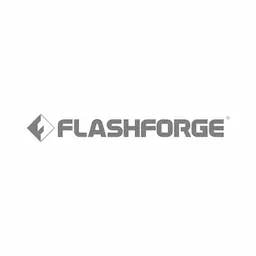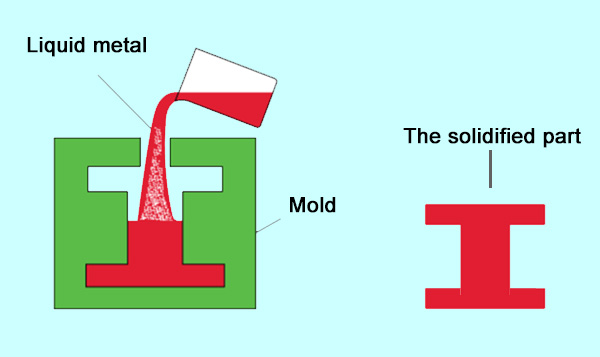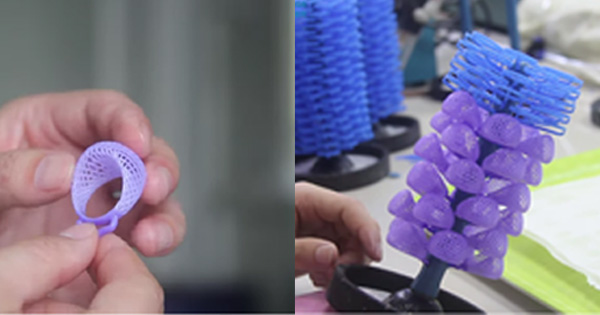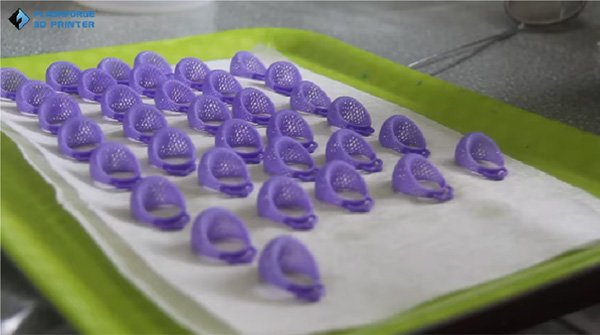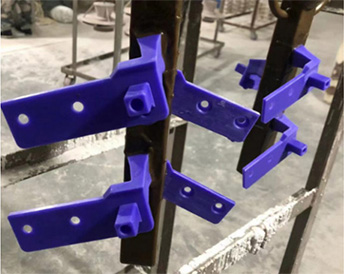Part 1. What is Investment Casting?
"Casting" is a manufacturing process where a liquid material (e.g., molten metal) is typically poured into a mold, which contains a hollow cavity of the desired shape (e.g., the 工 shape ), and then allowed to solidify. The solidified part (the metal 工 ) is then ejected to be the very stuff wanted by the manufacturers.
"Investment" is the noun of "invest" which has over 9 meanings when checking it on dictionary. While the most common meaning of "invest" is to spend money as an economic act (we say to invest money into Stock Market and earn profits), the meaning of "invest" is to cover, surround, or envelop something when it appears in the context of casting manufacturing.
In the process of investment casting, it begins with creating a wax pattern of the item (e.g., a wax finger ring). Getting wax rings assembled on a bolt (hence it looks quite like a wax tree), the wax ring tree is then be coated or "invested" with a refractory material to create a closed shell into which molten gold will be poured to form the desired parts ( gold finger rings). This investment material is typically liquid gypsum. The properties of gypsum plaster - like high melting point and resistance to thermal shock - make it ideal for use in the investment casting process.
▲A 3D printed wax ring ((Left) & Making wax tree (Right)
▲Putting wax trees to containers and investing it with liquid gypsum plaster
When the gypsum plaster shell gets harden under high temperature, the gypsum plaster shell would be turned upside down and the wax-made rings would be melted and drained away, leaving the gypsum plaster mold. The molten gold is then poured into this gypsum mold to create the final gold rings. And now, we know why investment casting is also known as lost-wax casting.
The investment casting industry is playing a vital role for manufacturing metal components in aerospace (turbine blades, engine components),in medial sector (hip/knee implants), in industrial machinery (intricate gears and levers), and in jewelry and art industry (rings, bracelet). Investment casting vs 3D printing, how are they related with each other?
Part 2. How could investment casting benefit from 3D printing technology?
Investment casting benefits from 3D printing technology in the preparation stages for investment casting - making wax patterns. 3D printing technology steps in here catering to a quick production of wax patterns.
Feeding the wax material with it, such a wax 3D printer directly printout a batch of wax rings. Steps are as followed:
① Digitally design wax 3D models on computer ---> ② 3D print them ---> ③ many wax rings done at the same time
In contrast, the traditional way of getting wax patterns are much more complex. Steps are as followed:
① A craftsman manually make a metal ring sample ---> ② coating it and making a silicon mold ---> ③ injecting liquid wax to the silicon mold to make a wax ring ---> ④ repeating the last step to make the second wax ring ---> ⑤ go on to make more wax rings...
In the traditional process, the first step of making wax ring patterns is creating a real metal ring pattern manually by a person as the product sample. This step can be very time and effort-consuming, particularly for intricate designs. After getting the metal ring sample ready, it still takes many steps before getting the bunch of wax rings to be used on wax tree.
In comparison of investment casting vs 3d printing, in the new way of 3D printing wax patterns we carve the sample model on computer software, which not only cut cost and cut manual efforts, but also saves our working result in a digital way. Next time for wax pattern creation, we won’t start from scratch! Besides, when using 3D printing technology, wax patterns are not 3D printed one by one, but 3D printed on the same plate at the same time!
▲3D printed wax rings
Part 3. Industrial User Story of 3D Printing for Investment Casting
Now that we know how investment casting benefits from 3D printing technology, let's rip into a real case of business user on how this Chinese investment casting foundry used Flashforge waxjet 3D printers to realize fast casting of metal from 3D prints.
Jiangyin Eibar Precision Casting Co., Ltd. is a Sino-Spanish joint venture that has engaged in investment casting for more than 20 years. It is committed to providing precision casting services to customers in various fields, and has been well received and recommended by global partners since its establishment.
Eibar Meeting Challenges in Precision investment Casting
In the early month 2023, Eibar Company received an order from a food machinery customer requiring 40 pieces of stainless steel part castings finished in two weeks. Had using traditional molding methods, it would have taken around two weeks to make wax part patterns. Adding the time for gypsum shell making and metal casting, it would have far exceeded the expected delivery time. In order to meet the customer's order demands within two weeks, Eibar company contacted Flashforge 3D Printing Service Center.
Rapid 3D Printing solution for Eibar Precision Casting
Upon receiving the wax part printing demand from Eibar, Flashforge assigned two sets of wax 3D printers - WaxJet 400 - to start printing work. The long-time continuous 3D printing performance of Flashforge Wax 3D printers enabled the 40 pieces of wax parts finished in 18 hours (from 5:00 pm that day to 11:00 am the next day). After a series of rapid post-processing operation, the 40 pieces of finished wax part patterns were successfully sent out at 12:00 noon the next day. In a nutshell, Flashforge finished 3D printing and delivered wax part patterns to Eibar company in less than 24 hours. Flashforge offered detailed 3D printing solution for investment casting and provided 3D printed models for casting.
Eibar started investment casting with the wax part patterns
After receiving the wax part patterns, the Eibar workshop workers began coating and making gypsum plaster shells. The subsequent casting only accounted for a small part of the total time period. After two and a half days, Eibar finished casting and delivered the stainless steel parts to its clients, shortening the expected time period by a whole week.
① Wax tree assembly for gypsum coating
② Casting liquid metal into gypsum plaster shell
③ Finished food machinery metal parts
Eibar company benefits from 3D printing technology
It took less than one day for Flashforge from receiving the print order to sending out the finished castable wax patterns. Compared to traditional casting methods, 3D printing wax patterns for investment casting offers numerous advantages. The real-time trimming and adjusting of the machinery part on the modeling software means that engineers can do fast verification of part models. They can modify and then 3D print a completely new physical part models within just several hours, while in traditional process it takes several days to readjust and remake molds for the machinery part samples. This not only reduces the time and cost, but also allows companies to iterate and make changes on the fly, significantly improving fault tolerance.
Investment casting vs 3d printing, the speed of 3D printing enables investment casting companies to complete orders within a shorter time frame, allowing them to meet production demands more efficiently. This is something that Eibar experienced firsthand, as they were able to deliver the finished casting products to their clients within two and a half days, much shortening time by a whole week.
of course, Flashforge received positive Feedback from Eibar company. "When I received the delivery, I didn't even think it was the wax patterns, because the delivery speed was too fast." The person in charge of Eibar said, "We have heard of 3D printing for investment casting a long time ago, but we have never had a chance to contact it before. This time, we took the opportunity of Flashforge 3D printing service and experienced it. It is convenient and fast, beyond our expectations."
Part 4. About the wax 3D printer eligible for investment casting
Flashforge WaxJet 400 3D printer is born for the investment casting industry. It proves how investment casting benefits from 3D printing with the following features:
- Realizes swift and efficient production of wax patterns.
- Enables investment casting companies to complete orders in shorter time.
- Cost and labor savings.
- Enables the creation of intricate and complex designs for wax patterns.
- Digital design and storage, allowing easy modification and reuse of designs.
- Simultaneous printing of multiple patterns.
- Improving fault tolerance for design modifications
▲Flashforge Waxjet 400
The adoption of Flashforge wax 3D printer into the production line of investment casting foundries in Southern China marks a significant stride forward in the industry. Investment cating and 3D printing. With the wax 3D printing technology, Flashforge has undoubtedly taken a leap ahead with the WaxJet series. The WaxJet 400, in particular, boasts a remarkable tri-printhead feature that effectively triples printouts, setting it apart in performance and efficiency. This makes it an incredibly valuable asset to those within the investment casting industry.
For investment casting foundries seeking to leverage this innovative 3D printing technology, please don't hesitate to contact us inquiring further about the 3D printing solution. We firmly believe that 3D printing is not merely a good choice, but rather a game-changing investment for those in the investment casting industry.
People who read this article also read:
3D Printer Used In Personalized Medicine: Making Patient-Specific Implants
3D printing in dentistry: use 3D printers to make wax dentures
Jewelry 3D printer debuts on JCK Jewelry show 2023



